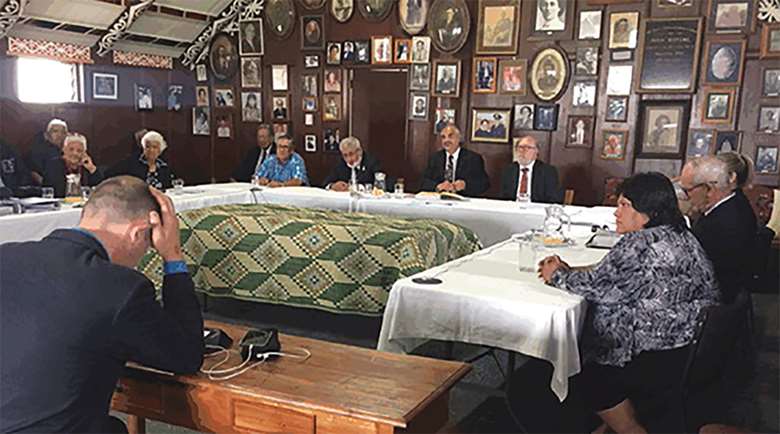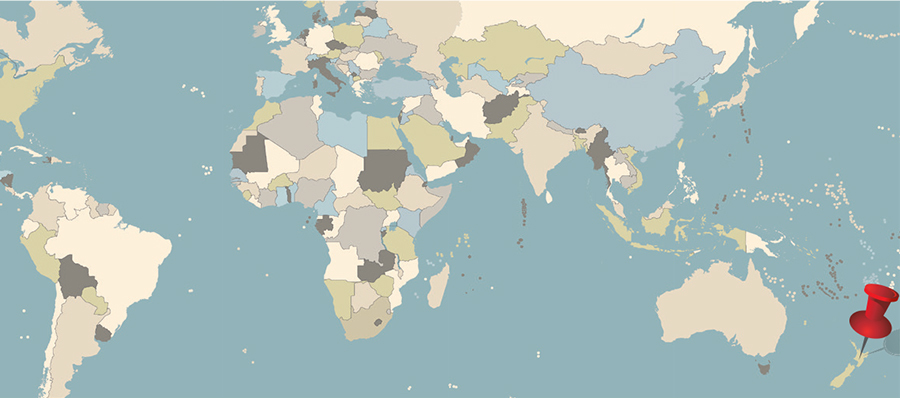International Focus: Community youth courts, New Zealand
Derren Hayes
Tuesday, August 28, 2018
Rangatahi Courts, Nga Koti Rangatahi, are a community-based court in New Zealand that deals with young offenders from Maori communities who have admitted guilt.

Rangatahi Courts, Nga Koti Rangatahi, are a community-based court in New Zealand that deals with young offenders from Maori communities who have admitted guilt.
They are an alternative to the youth court system, but operate in the same way. They are held on marae - communal or sacred places in Polynesian societies - and follow Maori cultural processes.
A similar system operates for young people from the Pacific Islands, Pasifika Courts. These are held in Pasifika churches or community centres and follow Pasifika cultural processes.
These courts are designed to help Maori and Pasifika young people to engage in the youth justice process. They are also designed to better involve Maori and Pasifika communities in the youth justice process.
There are 15 Rangatahi Courts in New Zealand, and two Pasifika Courts in the city of Auckland.
Nga Koti Rangatahi have been in existence for 10 years and were cited as a possible model for the UK to adopt in David Lammy MP's 2017 review of the treatment of black, Asian and minority ethnic (BAME) people in the criminal justice system.
CULTURE AND SOCIETY
New Zealand has a population of 4.8 million people, a quarter of whom live in Auckland, the country's largest city. Three-quarters of the population live on the North Island, home to the country's capital city Wellington.
At the 2013 census, 600,000 people identified themselves as Maori, the country's indigenous people. The Maori have lived in New Zealand for 700 years, with European settlers becoming established over the past 200 years.
As Western European cultural norms became dominant in New Zealand, Maori citizens have struggled to adapt. Maori communities have poorer health, education and economic outcomes than those of white heritage. Although Maori make up 12.5 per cent of the general population aged 15 and over, 42 per cent of arrests involve a person identifying as Maori, and half of those in prison are Maori.
The proportion of New Zealand young people aged 15 to 25 not in education, employment and training (Neet) is 12.4 per cent, but this rises to 22.4 per cent for Maori young people. Poorer outcomes for Maori young people are also seen in the youth justice system.
The rate of offending for Maori children aged 10 to 13 is 207 per 10,000 population, compared with a national average of 88/10,000. The disparity is even larger for 14- to 16-year-olds: the rate for Maori young people is 642 per 10,000 population, compared with an average of 285/10,000.
Since 2009/10, the overall rate of youth offending in the country has fallen considerably, but the decline has been at a slower rate for Maori (59 per cent) than for white young people (74 per cent).
While the overall number of young people who offend has decreased, official data shows the proportion who appeared in the youth court increased by 27 per cent over the same period, as less serious offending has fallen more substantially compared to serious or persistent offending.
The data highlights that young people who offend often have complex problems, which can be among the underlying causes of their offending. Of all 14- to 16-year-olds who offend, 43 per cent of males and 29 per cent of females led to court action or a family group conference (FGC) - four out of five of those referred for an FGC had a previous report due to concerns over care and protection.
REGULATION AND POLICY
Most children who offend are dealt with by the police through alternative action, like writing an apology letter or paying for damage.
When the offence is more serious, an FGC is used to give the child or young person a chance to own up to what they've done. They work with their extended family - whanau, victims and professionals to find solutions and make amends.
The aim is to help the child face up to their offending, learn from their mistakes, make positive choices and move on.
The whanau helps form a plan for their child that is then agreed by everyone in the conference. The whanau will also help ensure the plan is followed. It is at this stage that Rangatahi Courts are used.
The youth court is governed by the Children Young Persons, and Their Families (Oranga Tamariki) Legislation Act 2017. This updated the Oranga Tamariki 1989 Act and includes a number of important changes, including the extension of Youth Court Jurisdiction to include 17-year-olds until their 18th birthday. This change will apply from 01 July 2019.
The Oranga Tamariki Act 1989 promotes the wellbeing of children, young persons and their families and family groups. Section 4(f) sets out the objective most relevant for the youth justice system. It states that where young people commit offences, they are to be "held accountable, and encouraged to accept responsibility, for their behaviour" and "dealt with in a way that acknowledges their needs and that will give them the opportunity to develop in responsible, beneficial and socially acceptable ways".
General principles under Section 5 of the act provide that wherever possible, family and whanau should be involved in decisions affecting the child or young person, and that those relationships should be maintained.
The heads of six government departments are now accountable for protecting and improving the lives of vulnerable children. NZ Police, the Ministries of Health, Education, Justice and Social Development, and Ministry for Children have new legislated responsibilities.
Child protection policies have been adopted as standard by those agencies, along with the Ministry of Business, Innovation and Employment (Housing), district health boards and school boards.
PRACTICE
The Rangatahi and Pasifika Courts are for young people who have admitted the charges they are facing. After the FGC has decided on a plan for how the young person can take responsibility for what they did, the young person may be given the opportunity to have this plan monitored by the Rangatahi or Pasifika Court. This means that all court appearances until the plan is completed will be held on the marae or at a Pasifika venue. Normally, the young person will appear at the court every two weeks, and each hearing will usually involve the same Judge.
A typical hearing at a Rangatahi Court will start with a powhiri (welcome/calling) of manuhiri (visitors) onto the marae. After morning tea, the hearing of each young person's case starts. Each hearing begins with the young person receiving a mihi (talk) from the kaumatua (respected elders), showing respect to that young person and acknowledging their whanau links.
Also at the hearing will be the judge, police, kaumatua/kuia, social worker, court staff, whanau, the young person's lawyer, lay advocate and the victim if they choose to attend.
During the time the young person attends the Rangatahi Court, it is expected that they will learn their pepeha (traditional greeting of tribal identity) with the assistance of their lay advocate. At each hearing, the young person will practice delivering their pepeha.
A typical Pasifika Court hearing will involve a briefing between the judge and the elders to discuss how each young person is progressing with their plan. Each case will start and end with a prayer. An elder from the same cultural background as the young person will talk to them and their family, offering encouragement and guidance.
IMPACT
Rangatahi Court "is no soft option", says principal Youth Court judge John Walker. "A great deal is expected of the young people, especially from their elders," he adds. Kaumatua and kuia, lay advocates and mentors play a key role in guiding them toward gaining the cultural knowledge that they are expected to demonstrate to the court. Together, in collaboration with court professionals and under the leadership of the judge, the elders hold their rangatahi to account.
The courts strive to be victim-focused. At Whakatane's Mataatua Rangatahi Court, the local Maori people weave a whariki (mat) to represent the victim, and it is draped over a table in front of the judge.
Walker says the expansion of Rangatahi Courts has raised questions about how to measure their success. This is difficult to measure in terms of recidivism rates, he says, given the courts' short history and relatively small number of offenders involved.
"You would reasonably expect that if you deal with the underlying causes of offending effectively - and Rangatahi Courts are a good setting in which to do this - you will reduce a person's level of offending," he adds.
"The paramount measure of success is the contribution that culturally-adapted courts make to improving access to justice. Developing a culturally-adaptable system in settings to which individuals can relate and connect is the right thing to do."

FACTFILE
- There are 15 Rangatahi Courts in New Zealand and two Pasifika Courts in Auckland
- They are designed to better involve Maori and Pasifika families in the youth justice process
- At the 2013 census, 600,000 people identified as Maori, the country's indigenous people
- Maori communities have poorer health, education and economic outcomes
- 42 per cent of arrests involve a person identifying as Maori and half of those in prison are Maori
- The rate of offending for Maori children aged 10 to 13 is two and a half times the national average
EXPERT VIEW
By Professor Roger Smith, Durham University, and Sean Creaney, Edge Hill University
David Lammy's review expressed concern about the disproportionate criminalisation of young people of BAME origin. In response to such dramatic evidence of racial bias at the heart of the system, he recommended the introduction of "local justice panels" based on New Zealand's Rangatahi Courts model, where elders and community members take the lead in determining the outcome "when a child gets into trouble with the law" (Law Society Gazette, July 2017).
The panels would seek to be culturally-sensitive and facilitate children's meaningful engagement and participation in the process. They would seek to include contributions from key figures, including the involvement of a child's teacher, social worker and/or other relevant professionals such as representatives from the Child and Adolescent Mental Health Services. Providing the space for professionals and the community to take on a more active role in the process would help to tackle trust issues in the justice system and address the problem of racial bias.
The panels could offer a more principled and equal approach to youth crime. They must be positive and constructive, and seek to identify and respond to children's unmet and complex educative, health and social care needs. They would also need to avoid the shortcomings of previous measures at the threshold of the justice system, including referral orders and some diversionary schemes. This is where systemic racism is most acutely experienced, and this is why the system needs to be infused with a change of culture. We must not fail through just tinkering at the edges and lack of boldness in seeking out radical and just solutions.




